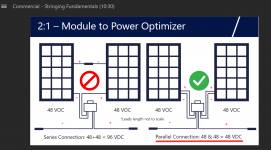solarken
NABCEP PVIP
- Location
- Hudson, OH, USA
- Occupation
- Solar Design and Installation Professional
Does anyone have any experience with SolarEdge commercial optimizers used in a 2:1 series arrangment (2 modules in series connected to one optimizer) like for the P1101 optimizer? I am specifically trying to find out how that meets NEC 2017 Rapid shutdown requirements of 80V within the array boundary. I am looking at options for a commercial system using Q-Cells modules that have just under 60V open circuit voltage at low temperature, so two in series would be just under 120V. I cannot find anywhere in solaredge docs how the optimizer keeps the voltage below 80V when it is not producing (in shutdown) with this arrangement of 2:1. Has anyone measured the voltage across the optimizer inputs (i.e. across two series modules) while it is off to see if it limits the voltage somehow to under 80? I have a vm into Solaredge design team but they often don't respond very promptly. Thanks.


